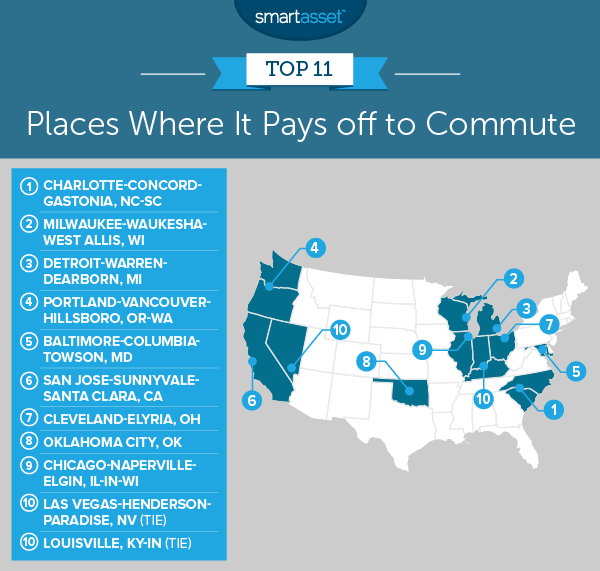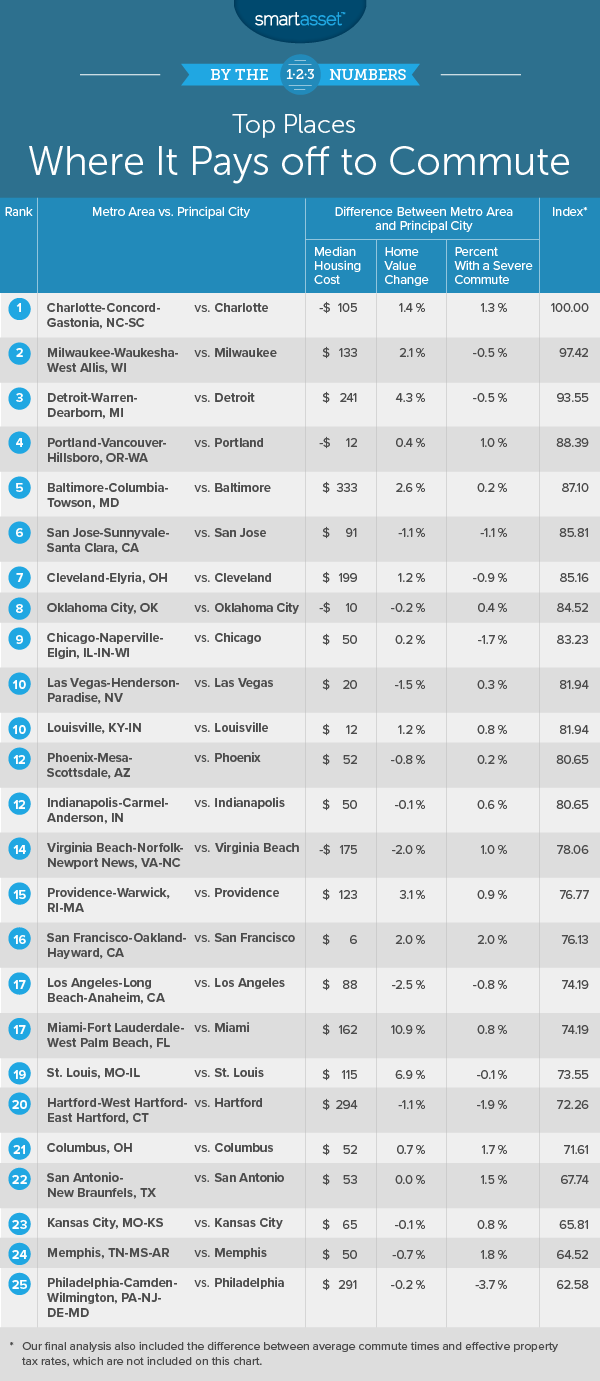Most people are faced with a trade-off when choosing where to live. You could move closer to the city center where most of the jobs are but face a more expensive mortgage and more cramped housing options or move outside of the city and enjoy more space but endure a longer commute. For every city and metro area, the math breaks down a little bit differently. In some city centers the cost of living is not much higher than the outlying metro area while some outlying metro areas have excellent commute options.
To make sense of this issue, SmartAsset analyzed data to find the places where it pays off the most to commute. We compared metro areas to their principal cities across five different factors. Specifically, we looked at the difference in housing costs, commute times, property taxes, home value change and the odds of a long commute. Check out our data and methodology below to see where we got our data and how we put it together.
Key Findings
- Midwest commuters do well – In total, four of the top 10 metro areas are in the Midwest. Residents in the outer metro areas tend to get access to lower property tax rates and faster rising home values. In particular the Detroit metro area fits this profile.
- Commuting isn’t always more affordable – Our data uncovered a few surprises. The average housing cost in many metro areas is actually more expensive than in their principal cities. Only three metro areas in the top 10 buck this trend. For example, in Baltimore, the cost of housing is about $330 more expensive in the metro area on average compared to the city. Keep in mind, however, that our housing cost data does not control for the size of homes. It is possible that residents living outside of principal cities pay less per square foot for housing but also live in larger homes.

1. Charlotte-Concord-Gastonia, NC-SC
According to our data, the Charlotte-Concord-Gastonia, North Carolina-South Carolina metro area is the most affordable one for commuters. Census Bureau data shows that you can save about $1,200 per year on average by living outside of the city of Charlotte but within the Charlotte metro area.
It is not just affordable housing that can be found in the Charlotte metro area, the long-term costs of homeownership are also lower than in the city. According to our data, property taxes in the outlying Charlotte area cost about 0.2% less per year than property taxes in Charlotte. For both of those metrics, this metro area ranks in the top 10.
2. Milwaukee-Waukesha-West Allis, WI
For residents around the Milwaukee-Waukesha-West Allis, Wisconsin area, it pays off to commute. According to our data, property taxes on average are much lower outside of the city. In total the average homeowner in the metro area pays 0.8% less per year in effective property tax than residents living in the city of Milwaukee.
Another plus for homeowners outside of Milwaukee is the value of the homes. Using Census Bureau data, we estimate the median home in the Milwaukee metro area increased in value by 2.1% more than the average home in the city of Milwaukee. That means while metro area residents may be paying more now for their homes (our data shows the outlying Milwaukee metro area is more expensive than Milwaukee proper), long term they have a better chance of selling their home for a big profit.
3. Detroit-Warren-Dearborn, MI
On average, homes in Detroit are affordable relative to the commuter cities and suburbs outside of it. However that is about the only cost commuters would be saving if they decided to live in Detroit vs. outside of the city. Our data shows that property taxes are nearly 2% lower on average outside of Detroit compared to inside the city proper.
Plus, homes values are appreciating much slower in the city compared to the metro area. The Census Bureau estimates that Detroit metro area home values appreciated over 4% faster from 2015 to 2016 than home values in the city did.
4. Portland-Vancouver-Hillsboro, OR-WA
If you are thinking about living outside of Portland and commuting, our data suggest it could be worthwhile. First of all, you could save on housing. According to our data, the Portland metro area ranks in the top 10 for amount of money saved by moving to the outlying metro area.
Furthermore residents living in the outer metro area face the same commute time as those living in Portland itself, on average. The average commute time for residents who live in the city of Portland is 27.4 minutes, while those living in the outer metro area have an average commute of 27.5 minutes.
5. Baltimore-Columbia-Towson, MD
Commuters have a lot to gain by choosing to live outside of Baltimore. Our research shows the homes outside of Baltimore are appreciating faster than those inside the city, plus the long-term cost of homeownership is also lower. Effective property tax rates in the Baltimore metro area are nearly 1% lower on average than property tax rates in the city. For that metric, the Baltimore metro area ranks third.
One drawback to living outside the city of Baltimore is the cost of housing. According to our data, you will be paying more for housing living outside of Baltimore than living inside of it, on average. Monthly housing costs in the Baltimore metro area are over $300 more expensive than in the city of Baltimore.
6. San Jose-Sunnyvale-Santa Clara, CA
San Jose-Sunnyvale-Santa Clara, California is a unique metro area. The average commuter actually spends less time commuting if they live outside of San Jose than inside of it. It ranks fourth in the study in this metric.
A concern for commuters, however, is the long-term costs. According to our data, commuters lose out on potential home value appreciation and pay nearly the same amount in property taxes.
7. Cleveland-Elyria, OH
Another Midwestern metro area takes seventh. There are numerous benefits to living outside of Cleveland and commuting in. Residents who live outside of Cleveland are 1% less likely to face a severe commute compared to those in the city. For that metric Cleveland ranks seventh.
A second metric in the Cleveland metro area’s favor is the rise in home values. Home values in the Cleveland metro area grew 1.2% faster than home values in the city of Cleveland.
8. Oklahoma City, OK
The Oklahoma City metro area ranks eighth. This metro area ranks in the top 30 for all our metrics. The Oklahoma City metro area is slightly more affordable than the city center, ranking 10th for difference in housing cost.
Plus, commute times in the OKC metro area are only slightly longer than those in the city, meaning you won’t save much time by living downtown as opposed to in a nearby suburb. Commuters face a 22.5 minute commute on average, while those who live in the city face a 21.7 average commute.
9. Chicago-Naperville-Elgin, IL-IN-WI
If you are looking for a smooth commute, your chances of finding one in Chicago are pretty slim. On average, people living in the city of Chicago spend 70 minutes commuting to and from work, per day. Residents outside of Chicago actually spend less time commuting than those inside the city of Chicago. According to our data, the average commute is 3.2 minutes shorter for commuter residents than city residents.
Plus, commuters saw their home values rise by 2.49% on average from 2015 to 2016. For Chicago homeowners that figure is lower at 2.26%.
10. (tie) Las Vegas-Henderson-Paradise, NV
Sin City comes in tied for our final spot. According to our data, commute times for residents living outside of Las Vegas are about 4% shorter than residents living in the city. For that metric, Las Vegas ranks sixth.
Home costs in the Las Vegas suburbs are comparable to costs inside the city. According to U.S. Census Bureau data, median housing costs in the Las Vegas metro area are $1,076 per month, while median housing costs in the city of Las Vegas are $1,056 per month.
10. (tie) Louisville, KY-IN
The Louisville metro area rounds out ranking. This metro area has balanced scores across the board and does not rank below-average in any single metric. Residents who are looking to invest in the housing market will appreciate living in the greater metro area, thanks to the rising home values.
According to our data, the average home in the Louisville metro area increased in value 1.2% faster than homes in the city of Louisville.

Data and Methodology
In order to find the most affordable metro areas for commuters, we looked at data for 50 cities and metro areas. We compared them across the following five metrics:
- Housing cost. This is the difference in the median housing cost for residents living in the metro area compared to residents living in the principal city of that metro area.
- Average commute times. This is the difference in the time it takes to travel to work, on average, for residents living in the metro area compared to residents living in the principal city.
- Property tax rates. This is the difference in the average effective property tax rates for the metro area compared to the principal city.
- Home value change. This is the difference between the percent change in home values from 2015 to 2016 in the metro area compared to the principal city.
- Severe commute times. This is the difference between the percent of residents living in the metro area who spend more than 60 minutes traveling to work compared to residents living in the principal city.
Data for all metrics comes from the Census Bureau’s 2016 1-Year American Community Survey.
First, we ranked all metro areas in every metric. Then we found each metro area’s average ranking, giving equal weight to all metrics. Using this average ranking, we created our final score. The metro area with the best average ranking received a 100 and the metro area with the worst average ranking received a 0.
Tips for Buying an Affordable Home
- Start saving before you’re ready – Buying a home is a long, expensive process. But you don’t want to make it any longer than it has to be by not having a down payment saved. According to our previous research, the average American homeowner needs to save for a few years before they have enough for a down payment. In order to make sure you’re financially ready to buy a home when you decide you are emotionally ready, start saving for your down payment as soon as you can.
- The extras can hurt – There is more to owning a home than just paying your mortgage. Other costs can include property taxes or homeowners insurance, depending on your circumstances. With this in mind it’s a good idea to understand the full cost of owning a home so you don’t accidentally buy one outside your affordability zone. New Jersey homeowners perhaps know the cost of property taxes the best. The average property tax bill in New Jersey is nearly $8,000 per year.
- Don’t get locked into a bidding war – If you find yourself putting in bid after bid on a home and the price is rising outside of what you are comfortable paying, it is probably a good idea to back out. No home, even your dream home, is worth buying if it means buying a home you can’t afford. Homeowners who are housing cost-burdened may be unable to save much money or prepare for retirement.
Questions about our study? Contact press@smartasset.com.
Photo credit: ©iStock.com/DenisTangneyJr
